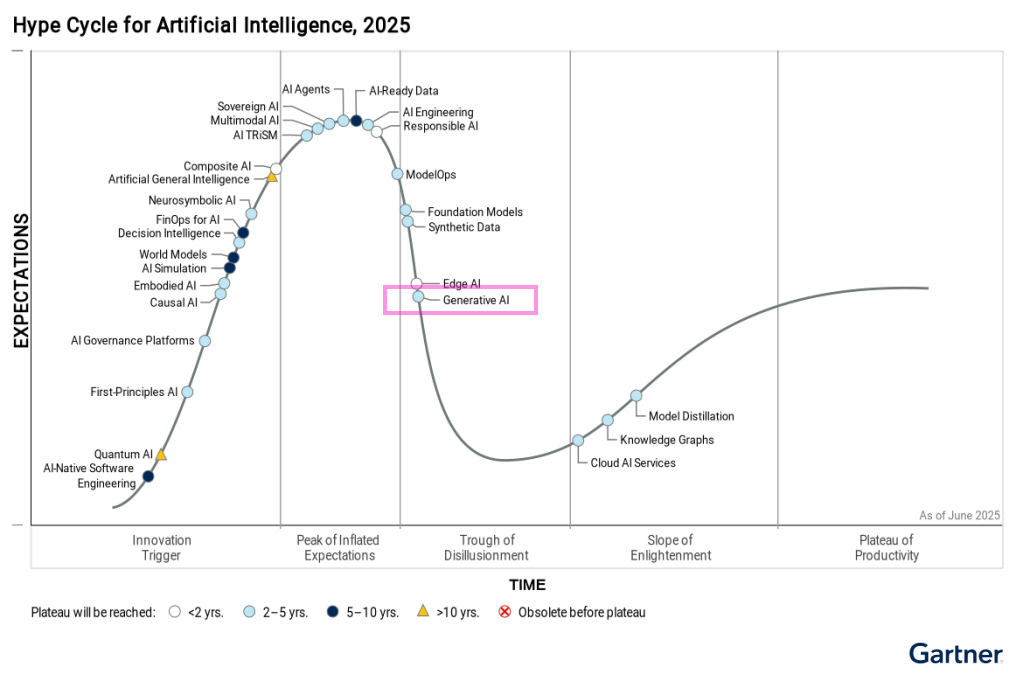The secret to AI adoption isn’t more technology. It’s preparing people to use it wisely. Gartner’s 2025 Hype Cycle for Artificial Intelligence may track the ups and downs of AI tools, but lasting success of any technology depends on the people who use them. Companies that focus on building fluency, confidence, and clarity within their teams will find AI adoption more sustainable than chasing trends.
TL;DR
-
Gartner’s 2025 Hype Cycle for Artificial Intelligence places Generative AI in the Trough of Disillusionment.
-
Headlines highlight failed pilots, high abandonment rates, and unmet expectations.
-
But not all technologies die in the trough, some, like the internet and e-commerce, reemerged as foundations of the modern world.
-
Generative AI aligns more with these foundational enablers than with short-lived fads

The Real Barrier to AI Adoption
Each year, Gartner’s Hype Cycle for AIcharts a familiar pattern: soaring expectations for new technologies, followed by a sharp plunge into disillusionment. Right now, generative AI is tumbling from the peak of inflated promises into the trough of hard reality.
Behind this curve, business leaders admit a common concern: “We’re not sure what’s real, what’s hype, or how to get our teams ready.”
The truth? The biggest barrier isn’t the technology. It’s the people. Teams lack confidence. Leaders don’t know which opportunities are worth pursuing. And without clarity, adoption stalls.
That’s why the path forward isn’t chasing hype, it’s preparing people to see clearly, learn confidently, and adopt responsibly.
Why the AI Hype Cycle Pushes Companies Into “AI Theatre”
As reported by MIT Sloan, Akamai CTO Robert Blumofe told the MIT Technology Review EmTech AI conference: “That’s the chain: AI success, theater, FOMO, and some form of failure. I’m seeing that happen again and again.” This captures how companies often fall into what he calls AI theater: rushing into splashy projects that look good but don’t deliver. The pattern echoes Gartner’s curve — excitement builds, expectations soar, but without preparation, results disappoint.
The root cause? A lack of AI fluency across the organization. Leaders don’t fully grasp what AI can (and can’t) do. Teams don’t see where it fits into their workflows. The result is projects that create headlines, not value.
How Generative AI Hype and Exaggerated Promises Put Businesses at Risk
As WIRED’s September, 2024 review of AI Snake Oil puts it, the book by Princeton University computer ccience professor Arvind Narayanan and PhD candidate Sayash Kapoor, “pinpoint the culprits of the AI hype cycle and advocate[s] for a more critical, holistic understanding.” In other words, organizations need literacy and skepticism to separate real value from overhyped claims, exactly the people-first preparation we focus on at Twenty44.
This is where the hype cycle turns costly. Chasing promises wastes time, budget, and, most importantly, trust. Once teams feel “burned,” they resist AI, even when new, more appropriate opportunities appear.
Businesses don’t need to deal with hype. They need a way to separate signal from noise, to assess and prepare their people to adopt AI in a sensible and responsible way.
A People-First Framework for Successful AI Adoption
By focusing on people first, organizations move past the hype cycle and into sustainable adoption. AI becomes less about exaggerated promises and more about practical progress.
Key Takeaway: Moving Beyond the Hype
With the right guidance, they can build fluency. With a focus on the right opportunities, they can filter out inflated promises, and adopt AI with clarity and confidence.
AI adoption succeeds when people are ready. That’s the Twenty44 difference.

Randy Matheson
Randy Matheson is an innovation strategist with a 25+ year proven track record of turning ideas into digital products. He specializes in working with Generative AI for content creation and using cutting-edge AI tools to create and interact with virtual audiences. He operates out Hamilton, Ontario where he resides with his partner and two large dogs.

